A Simulation Study of Global Evapotranspiration Components Using the Community Land Model
Abstract
:1. Introduction
2. Methods
2.1. Brief Model Introduction
2.2. Experiment Scheme and Data
3. Results Analysis
3.1. Canopy Interception Evaporation
3.2. Vegetation Transpiration
3.3. Soil Evaporation
3.4. Latent Heat Flux
4. Conclusions and Discussion
- (1)
- The seasonal variation in the spatial pattern of the Ec is determined by the seasonal variation in the spatial distribution of precipitation and the sum of LAI and SAI. Ec mainly concentrates in the latitudes of 15° S–15° N in the tropics, but it is relatively rare in the desert and glacial permafrost regions. The ability of CLM4.5 to simulate the spatial distribution of the Ec in January and April is relatively strong. The simulated means of Ec from CLM4.5 are smaller in comparison to the reanalysis data.
- (2)
- CLM4.5 simulates well the seasonal variation of Et and the distribution of high and low centers, but the simulation results in most areas are relatively larger than the reanalysis data, and the simulation bias is particularly focused in the equator and the South Asia regions. Since the simulated Et in CLM4.5 in tropical evergreen broad-leaved forests is relatively small compared to CLM4.0, and as the other main PFTs are relatively large, the simulation results of CLM4.5 of Et in equatorial regions is lower than that of CLM4.0, while the Et of most other regions are relatively higher than those of CLM4.0. Compared with CLM4.0, CLM4.5 has a stronger simulation capability to simulate the spatial distribution of global Et, and its means are closer to the reanalysis data.
- (3)
- Although there is a large difference in the simulation of the high and low centers of global Es distribution in CLM4.5 compared with the reanalysis data, CLM4.5’s ability to simulate the spatial pattern of global Et is better than that of CLM4.0. The simulation results of CLM4.5 for the spatial distribution of Es are worse than its results for Ec and Et. The simulated means of Es in CLM4.5 are closer than those of CLM4.0 to the reanalysis data, and the mean in October is almost entirely consistent with the reanalysis data. Compared with CLM4.0, the simulated Es in CLM4.5 in the middle and high latitudes of the Northern Hemisphere is significantly larger, although, only in October.
- (4)
- The simulated center position of the high and low values of latent heat flux and its seasonal variation in CLM4.5 are close to the reanalysis data. The ability of CLM4.5 to simulate the spatial distribution of the global latent heat flux in July is relatively strong. The simulated means of global latent heat flux in CLM4.5 is larger than the reanalysis data. The spatial distribution of the simulation bias of the latent heat flux in CLM4.5 is mainly determined by the bias distribution of Es rather than Et. The ability of CLM4.5 to simulate the spatial distribution of global latent heat flux shows little improvement relative to CLM4.0, but the simulation results of CLM4.5 on the means of latent heat flux have been improved.
Author Contributions
Acknowledgments
Conflicts of Interest
References
- Guo, X.Y.; Cheng, G.D. Advances in the Application of Remote Sensing to Evapotranspiration Research. Adv. Earth Sci. 2004, 19, 107–114. (In Chinese) [Google Scholar]
- Oki, T.; Kanae, S. Global hydrological cycles and world water resources. Science 2006, 313, 1068–1072. [Google Scholar] [CrossRef] [PubMed]
- Wang, S.; Pan, M.; Mu, Q.; Shi, X.; Mao, J.; Brümmer, C.; Jassal, R.S.; Krishnan, P.; Li, J.; Black, T.A. Comparing Evapotranspiration from Eddy Covariance Measurements, Water Budgets, Remote Sensing, and Land Surface Models over Canada. J. Hydrometeorol. 2015, 16, 1540–1560. [Google Scholar] [CrossRef]
- Mölders, N.; Raabe, A. Numerical Investigations on the Influence of Subgrid-Scale Surface Heterogeneity on Evapotranspiration and Cloud Processes. J. Appl. Meteorol. 2010, 35, 782–795. [Google Scholar] [CrossRef]
- Renger, M.; Strebel, O.; Wessolek, G.; Duynisveld, W.H.M. Evapotranspiration and groundwater recharge-A case study for different climate, crop patterns, soil properties and groundwater depth conditions. J. Plant Nutr. Soil Sci. 1986, 149, 371–381. [Google Scholar] [CrossRef]
- Wang, S.S.; Davidson, A. Impact of climate variations on surface albedo of a temperate grassland. Agric. For. Meteorol. 2007, 142, 133–142. [Google Scholar] [CrossRef]
- Su, Z. The Surface Energy Balance System (SEBS) for estimation of turbulent heat fluxes. Hydrol. Earth Syst. Sci. 2002, 6, 85–99. [Google Scholar] [CrossRef]
- Cleugh, H.A.; Leuning, R.; Mu, Q.; Running, S.W. Regional evaporation estimates from flux tower and MODIS satellite data. Remote Sens. Environ. 2007, 106, 285–304. [Google Scholar] [CrossRef]
- Seiler, C.; Moene, A.F. Estimating Actual Evapotranspiration from Satellite and Meteorological Data in Central Bolivia. Earth Interact. 2011, 15, 1–24. [Google Scholar] [CrossRef]
- Sun, S.; Chen, B.; Shao, Q.; Chen, J.; Liu, J.; Zhang, X.; Zhang, H.; Lin, X. Modeling Evapotranspiration over China’s Landmass from 1979 to 2012 Using Multiple Land Surface Models: Evaluations and Analyses. J. Hydrometeorol. 2017, 18, 1185–1203. [Google Scholar] [CrossRef]
- Lawrence, D.M.; Thornton, P.E.; Oleson, K.W.; Bonan, G.B. The Partitioning of Evapotranspiration into Transpiration, Soil Evaporation, and Canopy Evaporation in a GCM: Impacts on Land Atmosphere Interaction. J. Hydrometeorol. 2007, 8, 862–880. [Google Scholar] [CrossRef]
- Schlosser, C.A.; Gao, X. Assessing evapotranspiration estimates from the second Global Soil Wetness Project (GSWP-2) simulations. J. Hydrometeorol. 2009, 11, 880–897. [Google Scholar] [CrossRef]
- Wang, K.; Dickinson, R.E. A review of global terrestrial evapotranspiration: Observation, modeling, climatology, and climatic variability. Rev. Geophys. 2012, 50, 1–54. [Google Scholar] [CrossRef]
- Fang, X.; Luo, S.; Lyu, S.; Chen, B.; Zhang, Y.; Ma, D.; Chang, Y. A Simulation and Validation of CLM during Freeze-Thaw on the Tibetan Plateau. Adv. Meteorol. 2016, 2016, 1–15. [Google Scholar] [CrossRef]
- Oleson, K.W.; Lawrence, D.M.; Bonan, G.B.; Drewniak, B.; Huang, M.; Koven, C.D.; Levis, S.; Li, F.; Riley, W.J.; Subin, Z.M. Technical Description of Version 4.5 of the Community Land Model (CLM); NCAR Technical Note NCAR/TN+STR; National Center for Atmospheric Research: Boulder, CO, USA, 2013; pp. 1–434. [Google Scholar]
- Bonan, G.B.; Lawrence, P.J.; Oleson, K.W.; Levis, S.; Jung, M.; Reichstein, M.; Lawrence, D.M.; Swenson, S.C. Improving canopy processes in the Community Land Model version 4 (CLM4) using global flux fields empirically inferred from FLUXNET data. J. Geophys. Res. 2011, 116, G02014. [Google Scholar] [CrossRef]
- Sun, Y.; Gu, L.; Dickinson, R.E. A numerical issue in calculating the coupled carbon and water fluxes in a climate model. J. Geophys. Res. 2012, 117, D22103. [Google Scholar] [CrossRef]
- Swenson, S.C.; Lawrence, D.M.; Lee, H. Improved simulation of the terrestrial hydrological cycle in permafrost regions by the Community Land Model. J. Adv. Model. Earth Syst. 2012, 4, 1–15. [Google Scholar] [CrossRef]
- Xia, Y.; Mocko, D.; Huang, M.; Li, B.; Rodell, M.; Mitchell, K.E.; Cai, X.; Michael, B. Comparison and assessment of three advanced land surface models in simulating terrestrial water storage components over the United States. J. Hydrometeorol. 2017, 18, 625–649. [Google Scholar] [CrossRef]
- Jung, M.; Reichstein, M.; Bondeau, A. Towards global empirical upscaling of FLUXNET eddy covariance observations: Validation of a model tree ensemble approach using a biosphere model. Biogeosciences 2009, 6, 2001–2013. [Google Scholar] [CrossRef]
- Jung, M.; Reichstein, M.; Ciais, P.; Seneviratne, S.I.; Sheffield, J.; Goulden, M.L.; Bonan, G.; Cescatti, A.; Chen, J. Recent decline in the global land evapotranspiration trend due to limited moisture supply. Nature 2010, 467, 951–954. [Google Scholar] [CrossRef] [PubMed]
- Compo, G.P.; Whitaker, J.S.; Sardeshmukh, P.D. Review Article the Twentieth Century Reanalysis Project. Q. J. R. Meteorol. Soc. 2011, 137, 1–28. [Google Scholar] [CrossRef]
- Saha, S.; Moorthi, S.; Pan, H.; Wu, X.; Wang, J.; Nadiga, S.; Tripp, P.; Kistler, R.; Woollen, J.; Behringer, D. The NCEP Climate Forecast System Reanalysis. Bull. Am. Meteorol. Soc. 2010, 91, 1015–1057. [Google Scholar] [CrossRef]
- Dickinson, R.E.; Henderson-Sellers, A.; Kennedy, P.J. Biosphere-Atmosphere Transfer Scheme (BATS) Version 1e as Coupled to the NCAR Community Climate Model; NCAR Technical Note; National Center for Atmospheric Research: Boulder, CO, USA, 1993; pp. 1–80. [Google Scholar]
- Dai, Y.; Zeng, Q. A land surface model (IAP94) for climate studies part I: Formulation and validation in off-line experiments. Adv. Atmos. Sci. 1997, 14, 433–460. [Google Scholar] [CrossRef]
- Qian, T.; Dai, A.; Trenberth, K.E.; Oleson, K.W. Simulation of Global Land Surface Conditions from 1948 to 2004. Part I: Forcing Data and Evaluations. J. Hydrometeorol. 2006, 7, 953–975. [Google Scholar] [CrossRef]
- Oleson, K.W.; Niu, G.-Y.; Yang, Z.-L.; Lawrence, D.M.; Thornton, P.E.; Lawrence, P.J.; Stöckli, R.; Dickinson, R.E.; Bonan, G.B.; Levis, S.; et al. Improvements to the Community Land Model and Their Impact on the Hydrological Cycle. J. Geophys. Res. Biogeosci. 2008, 113, G01021. [Google Scholar] [CrossRef]
- Liu, B.; Ma, Z.; Xu, J.; Xiao, Z. Comparison of pan evaporation and actual evaporation estimated by land surface model in Xinjiang from 1960 to 2005. J. Geogr. Sci. 2009, 19, 502–512. [Google Scholar] [CrossRef]
- Zeng, X. Evaluating the Dependence of Vegetation on Climate in an Improved Dynamic Global Vegetation Model. Adv. Atmos. Sci. 2010, 27, 977–991. [Google Scholar] [CrossRef]
- Li, F.; Zeng, X.; Song, X.; Tian, D.; Shao, P.; Zhang, D. Impact of Spin-up Forcing on Vegetation States Simulated by a Dynamic Global Vegetation Model Coupled with a Land Surface Model. Adv. Atmos. Sci. 2011, 28, 775–788. [Google Scholar] [CrossRef]
- Lawrence, D.M.; Oleson, K.W.; Flanner, M.G.; Thornton, P.E.; Swenson, S.C.; Lawrence, P.J.; Zeng, X.; Yang, Z.-L.; Levis, S.; Sakaguchi, K.; et al. Parameterization improvements and functional and structural advances in version 4 of the Community Land Model. J. Adv. Model. Earth Syst. 2011, 3, M03001. [Google Scholar] [CrossRef]
- Liu, J.; Jia, B.; Xie, Z.; Shi, C. Ensemble Simulation of Land Evapotranspiration in China Based on a Multi-Forcing and Multi-Model Approach. Adv. Atmos. Sci. 2016, 33, 673–684. [Google Scholar] [CrossRef]
- Charney, J.; Quirk, W.J.; Chow, S.; Kornfield, J. A Comparative Study of the Effects of Albedo Change on Drought in Semi-Arid Regions. J. Atmos. Sci. 1977, 34, 1366–1385. [Google Scholar] [CrossRef]
- Murakami, S. A proposal for a new forest canopy interception mechanism: Splash droplet evaporation. J. Hydrol. 2006, 319, 72–82. [Google Scholar] [CrossRef]
- Murakami, S. Application of three canopy interception models to a young stand of Japanese cypress and interpretation in terms of interception mechanism. J. Hydrol. 2007, 342, 305–319. [Google Scholar] [CrossRef]
- Gash, J.H.C. An analytical model of rainfall interception by forests. Q. J. R. Meteorol. Soc. 1979, 105, 43–55. [Google Scholar] [CrossRef]
- Massman, W.J. The derivation and validation of a new model for the interception of rainfall by forests. Agric. Meteorol. 1983, 28, 261–286. [Google Scholar] [CrossRef]
- Zeng, N.; Shuttleworth, J.W.; Gash, J.H.C. Influence of temporal variability of rainfall on interception loss. Part I. Point analysis. J. Hydrol. 2000, 228, 228–241. [Google Scholar] [CrossRef]
- Muzylo, A.; Llorens, P.; Valente, F.; Keizer, J.J.; Domingo, F.; Gash, J.H.C. A review of rainfall interception modelling. J. Hydrol. 2009, 370, 191–206. [Google Scholar] [CrossRef]
- Dirmeyer, P.A.; Gao, X.; Zha, M.; Guo, Z.; Oki, T.; Hanasaki, N. The Second Global Soil Wetness Project (GSWP-2): Multi-Model Analysis and Implications for Our Perception of the Land Surface; COLA Technical Report 185; Center for Ocean-Land-Atmosphere Studies: Calverton, MD, USA, 2005; pp. 1–46. [Google Scholar]
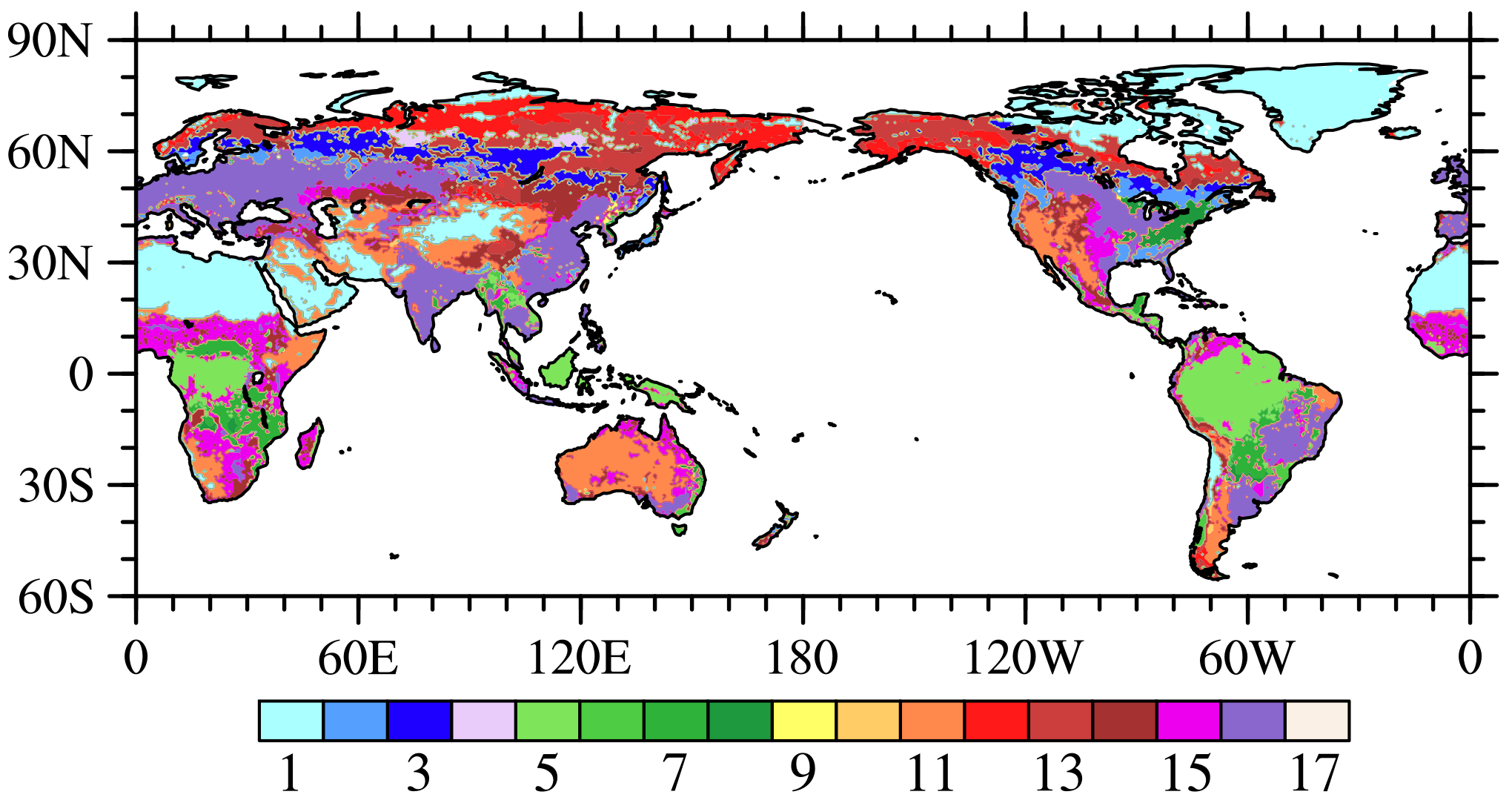

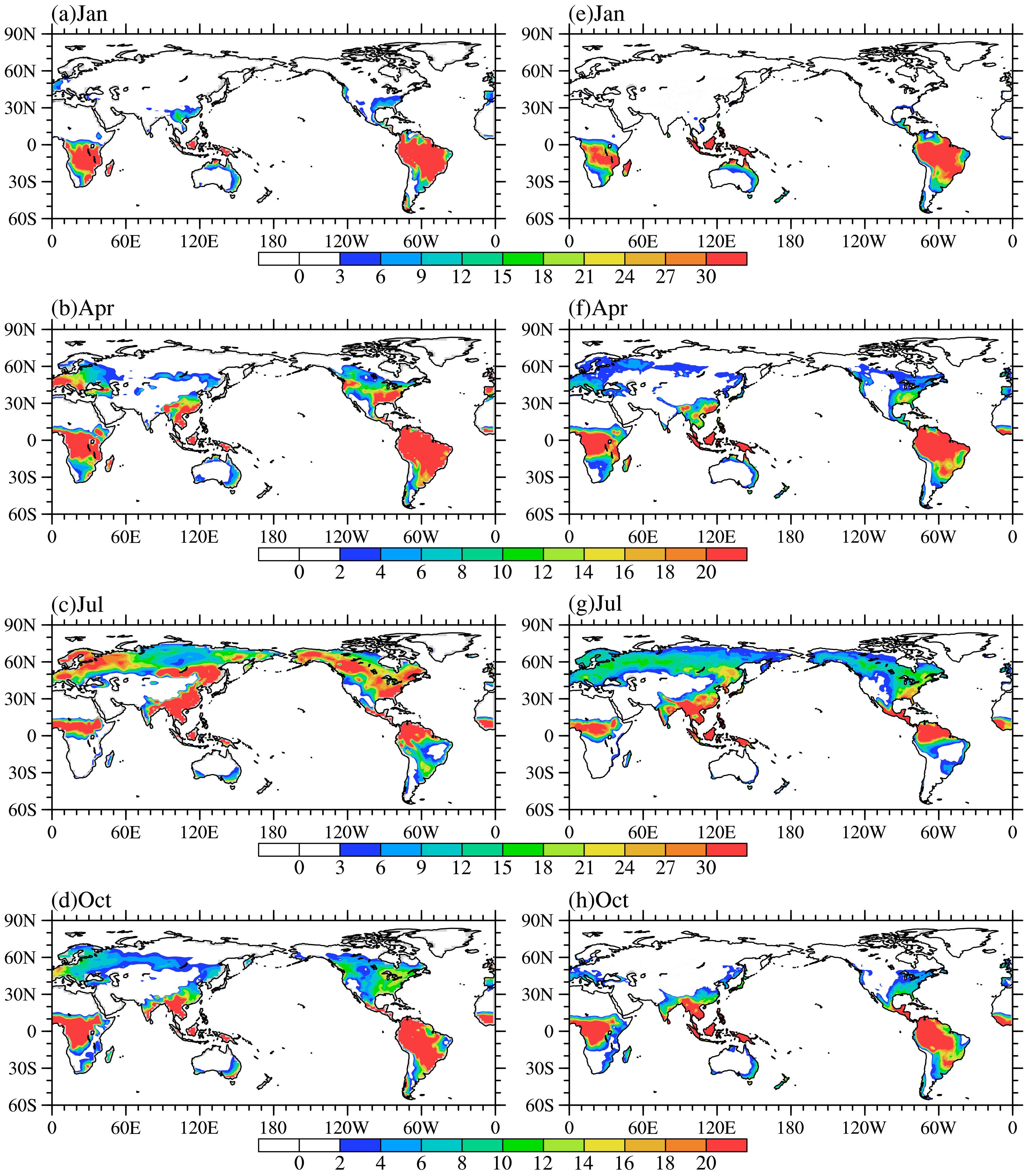

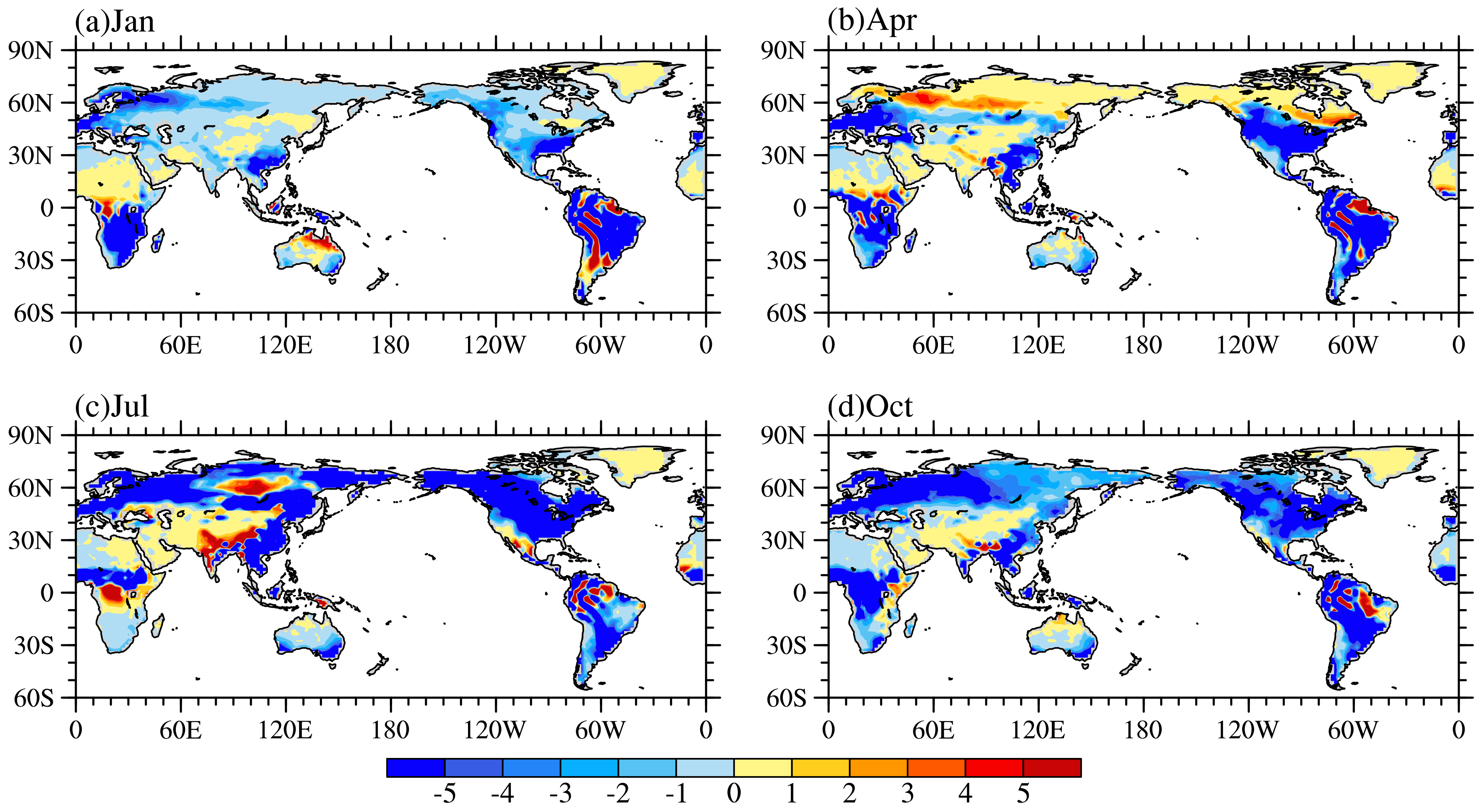
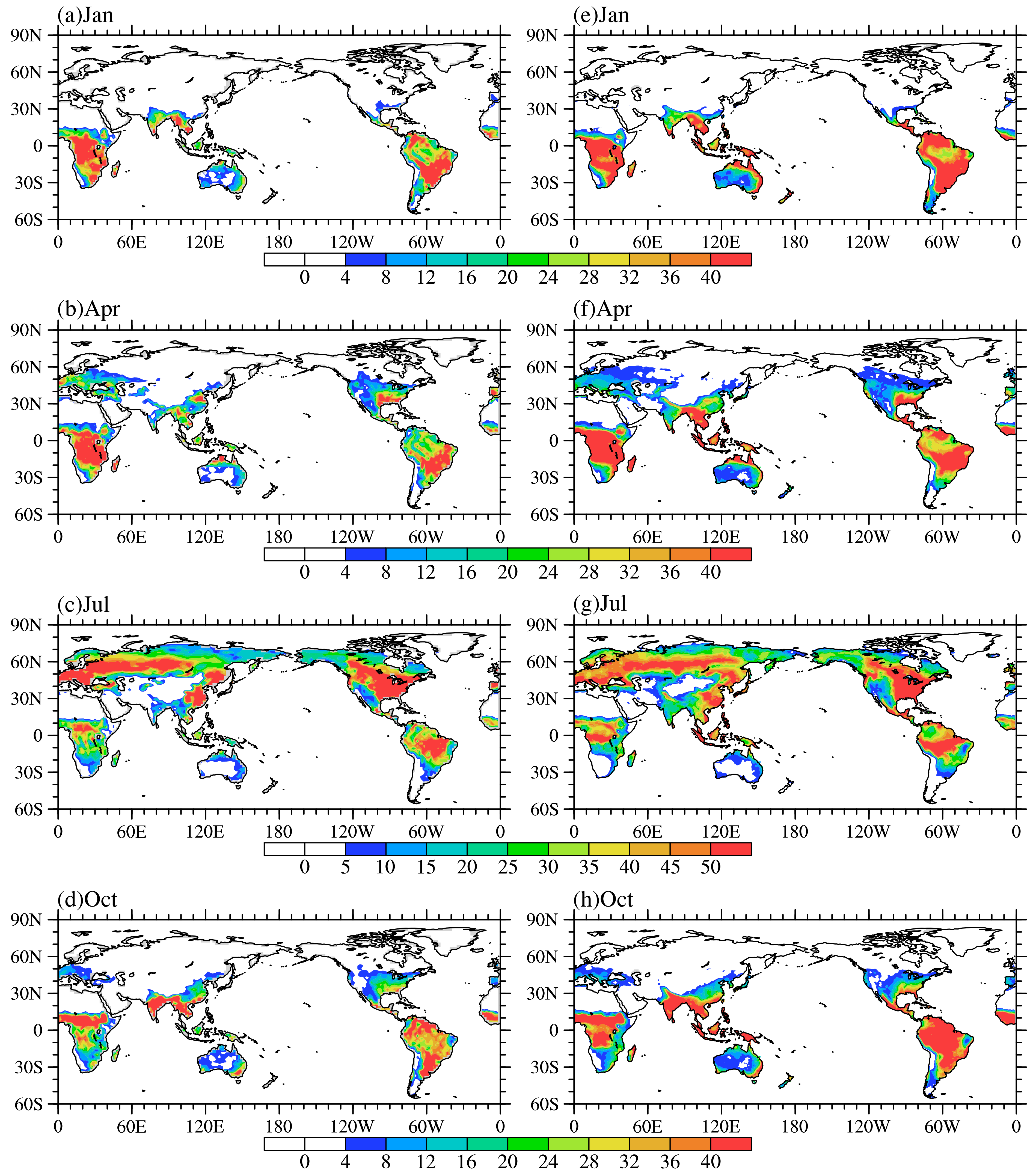

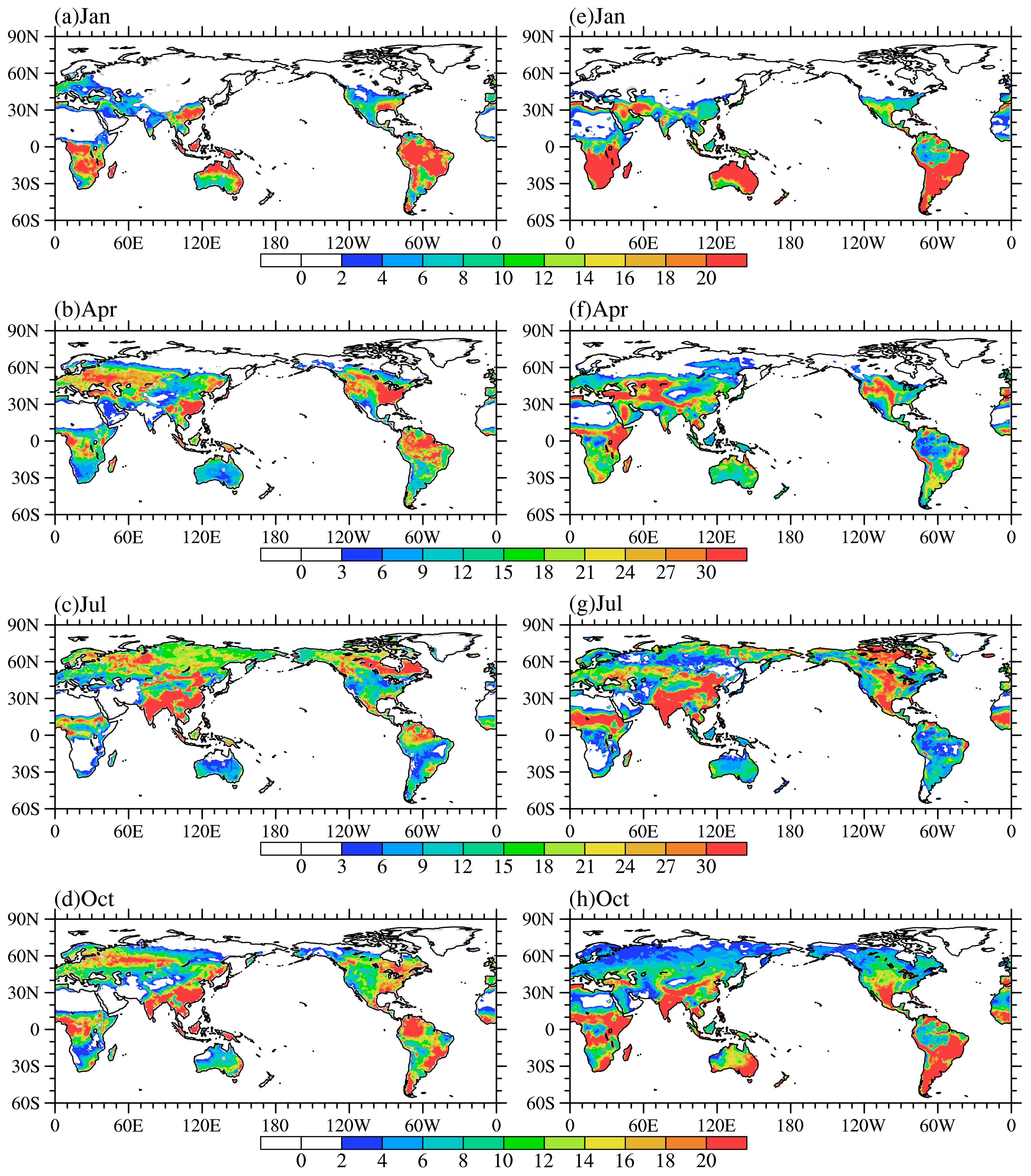
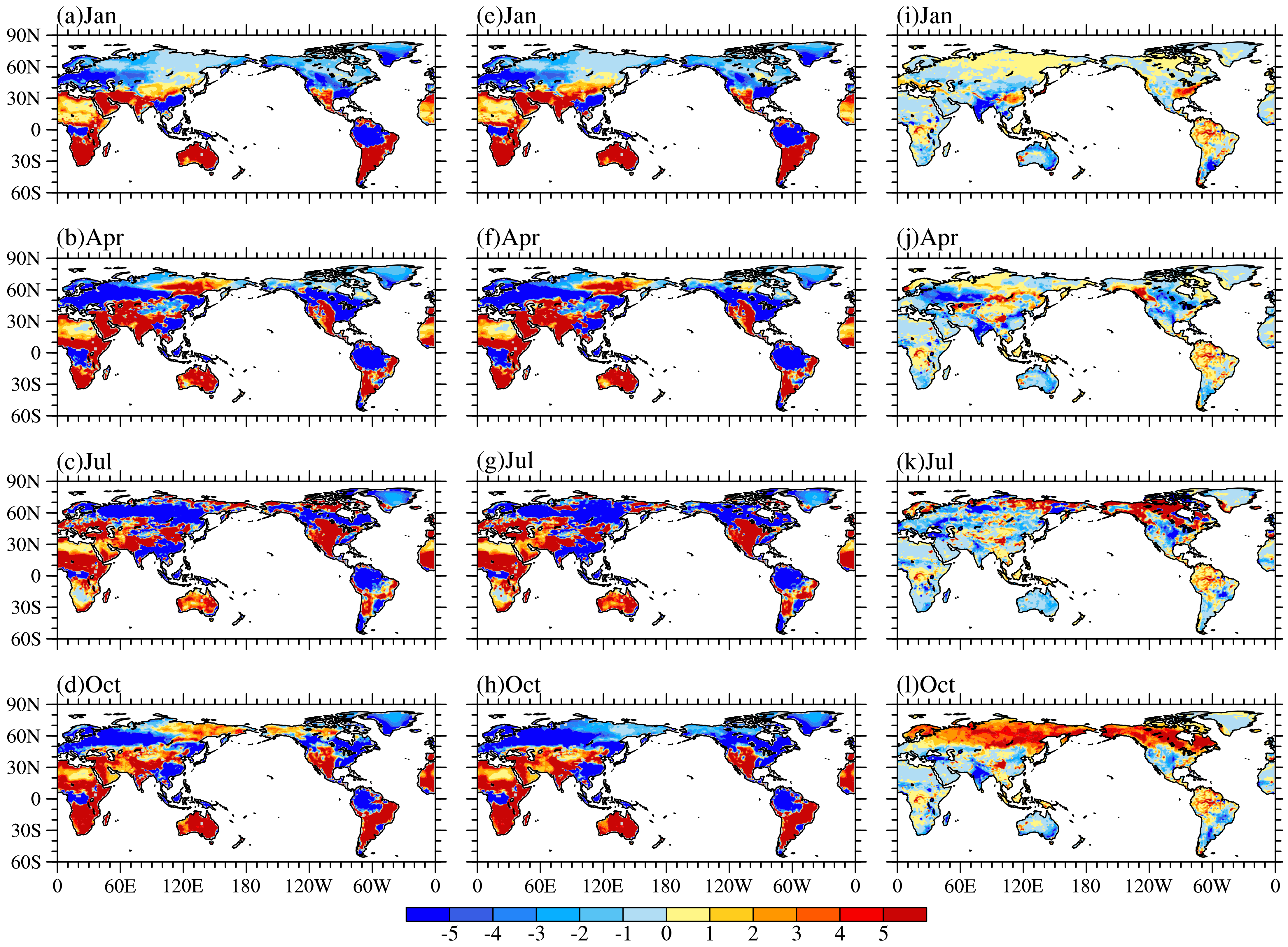
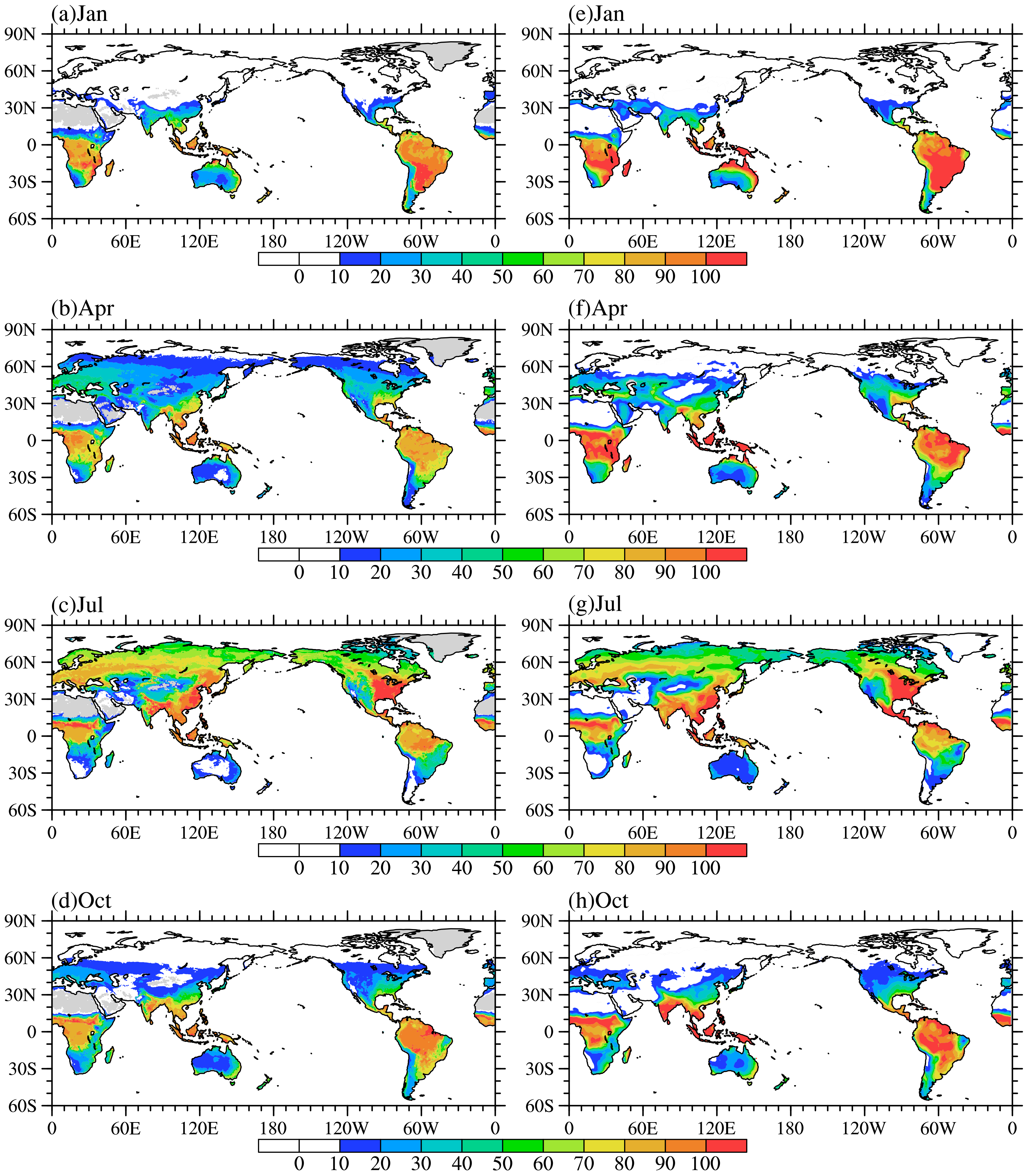
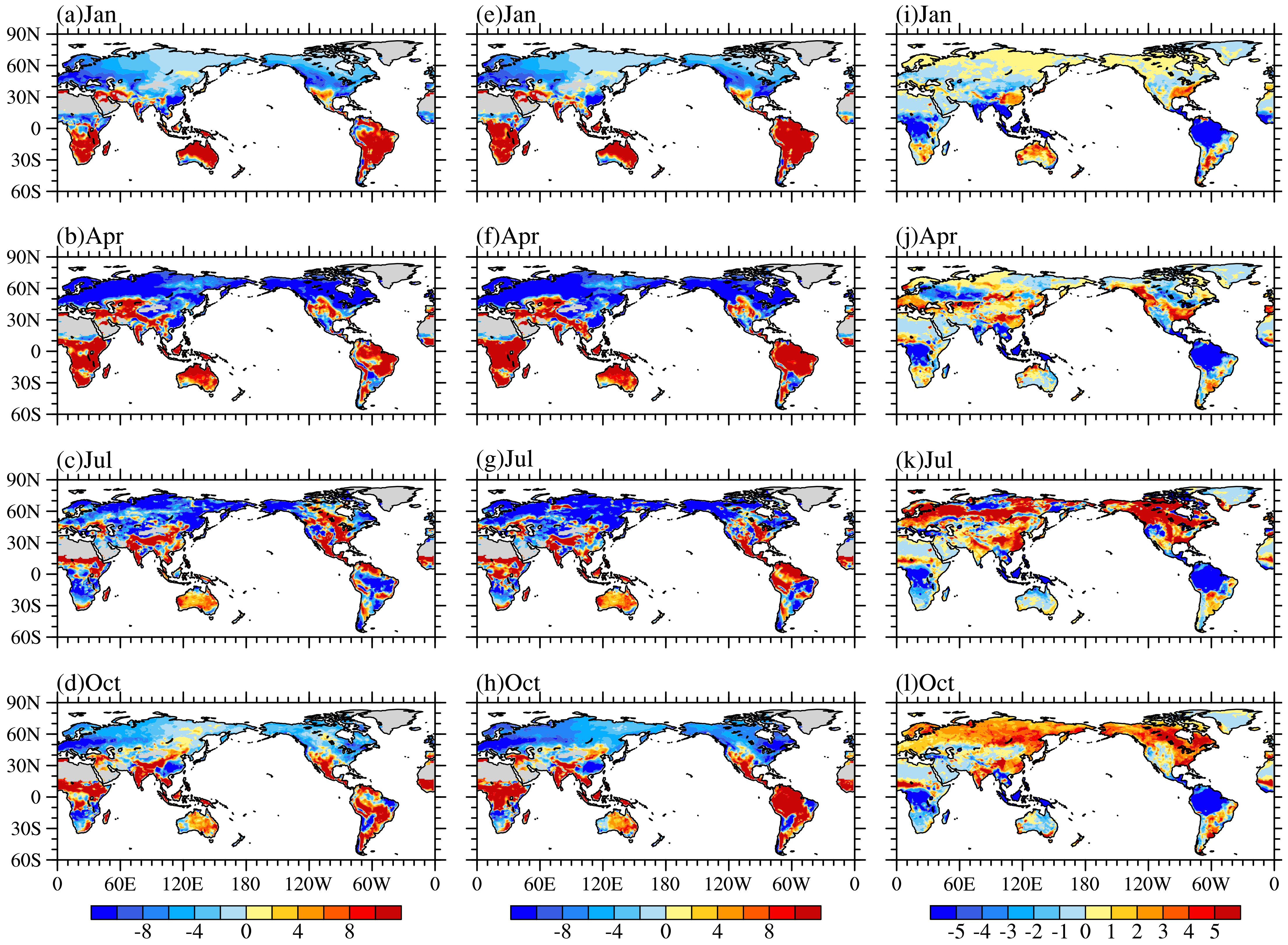
| RMSE (Units: W/m2) | Mean (Units: W/m2) | SCC | ||
|---|---|---|---|---|
| CLM4.5 | NOAA | |||
| January | 7.6 | 3.3 | 5.4 | 0.91 |
| April | 7.1 | 4.3 | 6.6 | 0.91 |
| July | 10.1 | 6.1 | 10.6 | 0.85 |
| October | 7.6 | 3.3 | 6.4 | 0.89 |
| Annual mean | 6.4 | 4.3 | 7.3 | 0.90 |
| RMSE (Units: W/m2) | Mean (Units: W/m2) | SCC | |||||
|---|---|---|---|---|---|---|---|
| CLM4 | CLM4.5 | CLM4 | CLM4.5 | NOAA | CLM4 | CLM4.5 | |
| January | 8.7 | 7.3 | 8.2 | 7.5 | 6.2 | 0.88 | 0.89 |
| April | 9.6 | 7.5 | 9.7 | 9.4 | 7.5 | 0.84 | 0.88 |
| July | 12.8 | 11.0 | 17.7 | 18.1 | 17.3 | 0.84 | 0.89 |
| October | 10.5 | 8.0 | 9.3 | 8.9 | 7.1 | 0.84 | 0.89 |
| Annual mean | 8.3 | 6.0 | 11.0 | 10.7 | 9.4 | 0.86 | 0.91 |
| PFT Number | PFT Name | CLM4.0 | CLM4.5 | CLM4.5-CLM4.0 |
|---|---|---|---|---|
| 16 | C3 dry land crops | 21.0 | 23.7 | 2.7 |
| 11 | temperate deciduous shrubs | 7.6 | 8.9 | 1.3 |
| 13 | boreal grassland | 6.8 | 7.3 | 0.4 |
| 14 | C3 grassland | 6.1 | 7.4 | 1.4 |
| 15 | C4 grassland | 23.1 | 24.7 | 1.6 |
| 12 | north deciduous broad-leaved shrubs | 10.0 | 12.2 | 2.2 |
| 5 | tropical evergreen broad-leaved forests | 54.9 | 43.4 | −11.5 |
| 3 | northern evergreen coniferous forests | 9.0 | 11.1 | 2.1 |
| RMSE (Units: W/m2) | Mean (Units: W/m2) | SCC | |||||
|---|---|---|---|---|---|---|---|
| CLM4 | CLM4.5 | CLM4 | CLM4.5 | NOAA | CLM4 | CLM4.5 | |
| January | 9.1 | 8.5 | 5.4 | 5.2 | 4.5 | 0.61 | 0.64 |
| April | 11.3 | 11.1 | 8.0 | 7.5 | 8.5 | 0.51 | 0.52 |
| July | 12.3 | 11.4 | 11.4 | 10.9 | 10.5 | 0.54 | 0.58 |
| October | 9.7 | 8.6 | 6.4 | 7.0 | 6.9 | 0.49 | 0.53 |
| Annual mean | 8.5 | 7.9 | 7.8 | 7.5 | 7.6 | 0.50 | 0.53 |
| RMSE (Units: W/m2) | Mean (Units: W/m2) | SCC | |||||
|---|---|---|---|---|---|---|---|
| CLM4 | CLM4.5 | CLM4 | CLM4.5 | FLUXNET | CLM4 | CLM4.5 | |
| January | 13.2 | 12.1 | 16.7 | 15.8 | 15.4 | 0.97 | 0.97 |
| April | 16.5 | 15.2 | 21.7 | 21.0 | 20.5 | 0.93 | 0.92 |
| July | 15.8 | 14.5 | 34.8 | 34.7 | 30.4 | 0.87 | 0.88 |
| October | 12.3 | 10.2 | 18.9 | 19.0 | 18.1 | 0.97 | 0.96 |
| Annual mean | 9.7 | 11.8 | 22.8 | 22.3 | 20.7 | 0.93 | 0.91 |
| Southeastern China | Siberia | Southeastern United States | Amazon | Europe | |
|---|---|---|---|---|---|
| Ec | −0.29 | 0.10 * | −0.38 | −0.21 | −0.31 |
| Et | −0.32 | −0.34 | −0.23 | 0.46 | −0.05 * |
| Es | 0.46 | 0.70 | 0.61 | −0.03 * | 0.74 |
© 2018 by the authors. Licensee MDPI, Basel, Switzerland. This article is an open access article distributed under the terms and conditions of the Creative Commons Attribution (CC BY) license (http://creativecommons.org/licenses/by/4.0/).
Share and Cite
Yang, M.; Zuo, R.; Wang, L.; Chen, X. A Simulation Study of Global Evapotranspiration Components Using the Community Land Model. Atmosphere 2018, 9, 178. https://doi.org/10.3390/atmos9050178
Yang M, Zuo R, Wang L, Chen X. A Simulation Study of Global Evapotranspiration Components Using the Community Land Model. Atmosphere. 2018; 9(5):178. https://doi.org/10.3390/atmos9050178
Chicago/Turabian StyleYang, Minghao, Ruiting Zuo, Liqiong Wang, and Xiong Chen. 2018. "A Simulation Study of Global Evapotranspiration Components Using the Community Land Model" Atmosphere 9, no. 5: 178. https://doi.org/10.3390/atmos9050178





